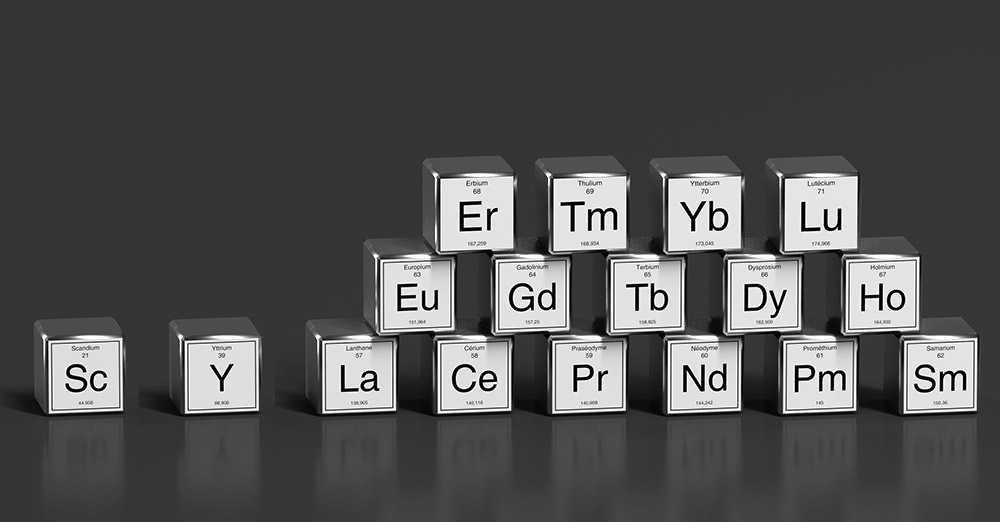
Selective Bonding: Until now, rare earth metals desirable as raw materials could only be separated from each other with great effort. But in the future, a protein isolated from bacteria could greatly simplify this separation, researchers report in the journal Nature. In testing, the lamodulin protein was able to separate important raw materials such as neodymium and dysprosium from each other with a good 98 percent yield and purity – in a single step. By specifically modifying its binding sites, it can also be adapted to other rare earths.
Whether neodymium, scandium, ytterbium or praseodymium: rare earth metals are indispensable to many modern technologies and are therefore in demand. But above all, the processing of rare earth ores is very complicated. Because the 17 rare earth elements are chemically and physically very similar, it is difficult to separate them using common extraction methods.
Separation is the problem
Although Europe’s largest rare earth deposit was only recently discovered in Sweden, it remains unclear how and where these ores are processed. It is true that rare earth metals can be particularly enriched from solutions of other metals by physical processes such as Joule flash heating or with the help of cyanobacteria. However, it takes a long time to separate the individual elements from each other and restore them in their pure form:
“Conventional rare-earth aqueous mineral separation processes use organic solvents such as kerosene and toxic phosphonates, and require dozens, sometimes hundreds of steps to recover extremely rare earth oxides,” said Joseph Mattox of Penn State University and colleagues. Therefore, scientists have long been searching for organic natural materials that could enable more efficient and simpler separation.

Bacterial protein binds rare earth metals
Now Mattocks and his team have found what they’re looking for: They’ve discovered a natural protein that naturally has a particularly high affinity for certain rare-earth metals. This lanmodulin protein is produced by the bacterial species Hansschlegelia quercus, which was only recently discovered in oak buds. Lanmodulin has four hand-like binding pockets with which it can bind metal atoms, including rare earths.
As the researchers discovered, the newly discovered lanmodulin has an affinity for rare-earth minerals about 100 million times greater than other minerals such as calcium. Binding to rare earths causes a change in the conformation of the protein, causing two molecules to unite and enclose up to three rare earth ions. In this regard, the team reports that the new lamodulin is significantly superior to previously known versions of this protein.
Separation of neodymium and dysprosium in the test
However, the critical factor is that lanmodulin does not interact in the same way with all REEs, but prefers to bind to lighter elements from this group. As a result, it can be used to separate rare earth mixtures typical of many ores. “So we investigated how well lamodulin can separate rare-earth metals like neodymium and dysprosium, which are important components of permanent magnets,” says Mattox and his team.
To do this, the researchers first obtained larger amounts of a protein produced by genetically manipulated Escherichia coli bacteria. They then attached these proteins to the surface of the nanoparticles, which acted as a support and filtration material. For the actual test, the scientists then ran a solution containing five percent dysprosium and 95 percent neodymium, which is typical for electronic scrap recycling, through a columnar filter with these grains in it.
The result: “After just one cleaning step, we were able to recover 98 percent of the neodymium with a purity of 99.8 percent,” say the team. The lamodulin nanospheres selectively bound neodymium ions and allowed dissolved dysprosium to pass through. A version of lanmodulin was slightly modified in its amino acid sequence until it achieved more than 98 percent purity and a 99 percent yield for each of the rare earth metalloids—in just one step.
A useful starting point for further improvements
According to the researchers, these results show that the bacterial lamodulin proteins are not only suitable for the extraction of REEs from mineral solutions — they can also facilitate and shorten the separation of various REEs. Elution with 0.1 M HCl was sufficient to remove neodymium from the lamodulin nanocapsules, for example.
Therefore, Mattox and his team consider it useful to continue research on lamodulin as adsorbents for rare earths. Since they have studied in detail the binding of these molecules to these elements, their study also opens up other possibilities for altering and improving the selectivity of these proteins. (Nature, 2023; Two: 10.1038 / s41586-023-05945-5)
What: Nature